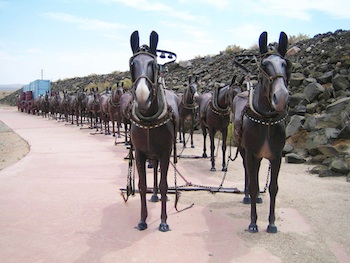
Boron upgrades from twenty mules to a gigabit.
On its fourth try, Race Telecommunications seems set to get public grant backing to build a fiber-to-the-home system in the small Mojave desert town of Boron. California Public Utilities Commission staff have released a draft resolution that, if approved by commissioners, would spend up to $3.4 million from the California Advanced Services Fund (CASF) to pay 60% of the cost of building a fiber optic network to serve about 900 customers in the Boron area, plus cover the cost of any state or federal income tax on the grant.
I wrote a long piece on the background of the Boron project in October 2012, when Race tried for 70% funding. That proposal was rejected because poor broadband service is available in the area. In order to qualify for 70% funding last year, projects had to be in areas with absolutely no wireline or terrestrial wireless broadband service at all. None of the projects submitted back then qualified.
In the current round, broadband infrastructure projects can get 60% of construction costs subsidised by CASF if the service area is underserved, which means, by California standards, there is no broadband service available that meets a minimum of 6 Mbps download and 1.5 Mbps upload speed.
Charter Communications tried to contest Race’s application, on the basis of coverage claims it provided to the CPUC’s broadband mapping program. On closer look, with the exception of a small area near Edwards Air Force Base, those claims turned out to be false and the challenge was rejected. Similarly, Verizon could not substantiate its blanket protest of CASF grant applications either. After trimming the area around Edwards, CPUC agreed with Race’s analysis that the Boron area is underserved.
Race also tried twice, and failed, to get grants from the federal broadband stimulus program in 2009 and 2010, for projects in Boron and other Kern County desert communities. Last February, it submitted five CASF applications. Two, for Mojave and California City, were rejected after Charter upgraded service, one in the Tehachapi area has also been recommended for approval and another, for four communities in Mono County, is still under review.
If approved, the Boron and Mono County systems will be two more victories for the Digital 395 project, which will shortly span eastern California with middle mile fiber stretching from Reno to Barstow. Both rely on Digital 395 for cheap backhaul, allowing Race to offer up to a gigabit of service for monthly prices ranging from $25 for 25/15 Mbps down/up, to $150 per month for 1 Gbps/100 Mbps. Further north, in Mammoth Lakes, Suddenlink has already boosted download speeds to 15 Mbps, up from the 1.5 to 3 Mbps range, at no additional cost to subscribers thanks to abundant bandwidth from Digital 395.
Commissioners are scheduled to vote on the Boron proposal at their 31 October 2013 meeting. A handful of other draft CASF project resolutions are expected to be released in the next few days, also to be considered at that meeting.
Tellus Venture Associates assisted with several CASF proposals in the current round, so I’m not a disinterested commentator. Take it for what it’s worth.
